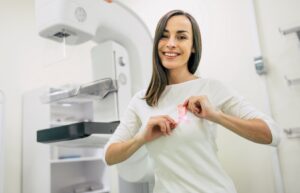Schedule Your Mammogram—October 20th is National Mammography Day
Turning 40 is a significant milestone worth celebrating! You aren’t over the hill. You are a grown woman who has made it through everything life has thrown you so far. Throw yourself a party and honor yourself.
After the party, take some time to stay on top of your preventative health because, as a woman, it’s also the time to start getting a mammogram.
What is a mammogram?
A mammogram is a special kind of X-ray image taken of a woman’s breast. It’s used to check for any lumps or changes in the breast tissue that might be a sign of breast cancer. During a mammogram, the breast is gently pressed between two flat plates to get clear pictures. Mammograms are essential for detecting breast cancer early when it’s easier to treat.
What should be expected during a mammogram?
Feeling nervous about getting a mammogram is normal, especially if it is your first time. This is a routine medical exam designed to be as efficient as possible. Here is what to generally expect at your mammogram screening in New Jersey at ImageCare Radiology:
- During your appointment, you will be given a private area to undress from the waist up. You’ll typically wear a gown that opens in the front, which allows easy access to your breasts while keeping you covered.
- You will be guided to a room with a mammography machine. The technologist, a trained healthcare professional, will explain the procedure and answer any questions.
- The technologist will position your breast between two flat plates on the mammography machine to get clear images of your breast tissue. The plates gently press your breast, which may feel tight and uncomfortable. Compression is necessary to spread the breast tissue for better imaging and to reduce the radiation dose. It will feel weird, but it shouldn’t cause extreme pain.
- Remember, while the compression may be briefly uncomfortable or even a little painful for some women, it should only last for a few seconds with each image. Communicate any discomfort to the technologist so they can adjust the pressure as needed.
- Typically, two or more images are taken of each breast—one from top to bottom and another from side to side. For each view, you will need to hold your breath for a few seconds to minimize movement and ensure clear images.
- After the images are taken, they will be reviewed by a radiologist, a specialized doctor who interprets medical images. Your healthcare provider will receive the results and discuss them with you. If there are any concerns or if further evaluation is needed, additional tests, such as a follow-up mammogram or breast ultrasound, may be recommended.
Don’t put off your mammograms!
If you have breast cancer, the sooner it is detected, the better so that effective treatments can be pursued. If you have a family history of breast cancer or other risk factors associated with breast cancer, you may need to start this process sooner. Talk to your doctor and do what you must to protect your health because your life matters.